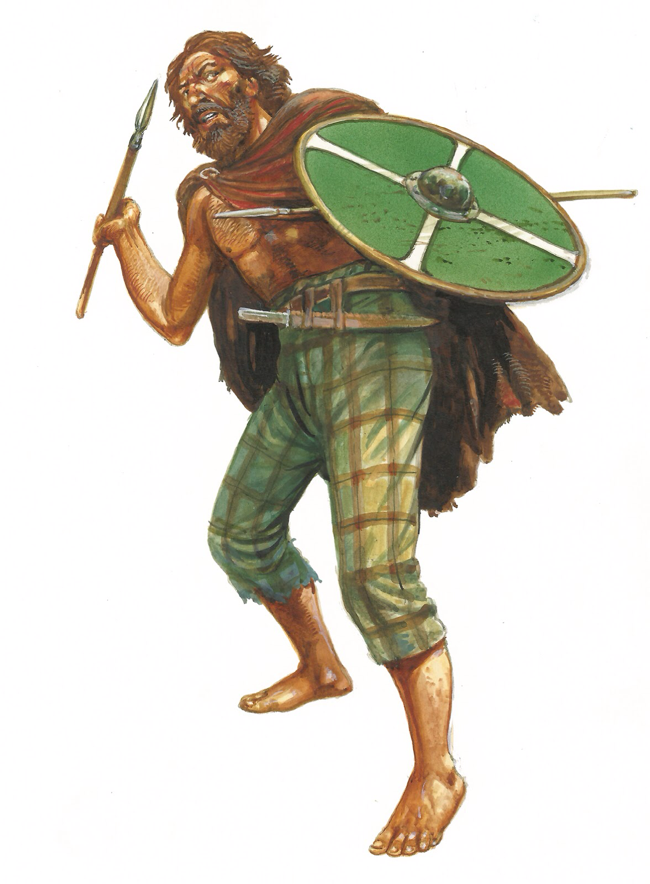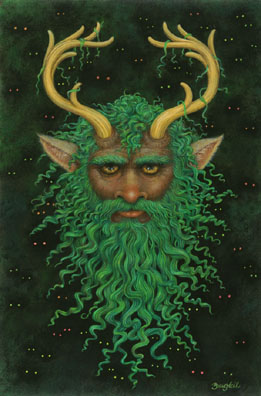 According to the Vita Kentigerni Merlin, originally Myrddin, fought at the Battle of Arfderydd and afterward lived in the woods as a wildman. The only record to date the event, the Annales Cambriae, gives 573 as the year. Of course, 573 is too early in post-Roman Britain’s history to expect accurate dates. Given the source’s maximum variance in the late sixth and early seventh centuries the event could have taken place between 570 and 576.
According to the Vita Kentigerni Merlin, originally Myrddin, fought at the Battle of Arfderydd and afterward lived in the woods as a wildman. The only record to date the event, the Annales Cambriae, gives 573 as the year. Of course, 573 is too early in post-Roman Britain’s history to expect accurate dates. Given the source’s maximum variance in the late sixth and early seventh centuries the event could have taken place between 570 and 576.
The Vita Kentigerni at this point takes place around 600, and finds the crazed Merlin appearing out of the woods and being taken to Kentigern. The Strathclyde holy man was told that Merlin could predict the nature of a person’s death. The connection to Kentigern is an interesting one. As I have demonstrated in a soon-to-be-out book, Arthur was only active for the first pair of decades in the sixth century at the latest. But if Merlin was around in 600 then he could not have been born by the time Arthur died.
 In any event, Kentigern tested Merlin by arranging to have him see the same person three times without knowing it. Merlin predicted three different deaths for the man – that he would be chased down by dogs, that he would be pierced by sharp weapons, and that he would fall from a great height. Later that day the man in question was chased down by hunting dogs, fell from a cliff, and was pierced by stakes at the end of his fall; all three of which would have killed him. Merlin then predicted the circumstances of Kentigern’s death and disappeared into the forest never to be seen again.
In any event, Kentigern tested Merlin by arranging to have him see the same person three times without knowing it. Merlin predicted three different deaths for the man – that he would be chased down by dogs, that he would be pierced by sharp weapons, and that he would fall from a great height. Later that day the man in question was chased down by hunting dogs, fell from a cliff, and was pierced by stakes at the end of his fall; all three of which would have killed him. Merlin then predicted the circumstances of Kentigern’s death and disappeared into the forest never to be seen again.
But his legend was only beginning. The mid-seventh century would see the end of all the British kingdoms in Scotland apart from Strathclyde, and its kings would begin collecting the stories of the northern Britons. In time, Arthur would become the center of those hero tales, slowly absorbing individuals from further and further away both chronologically and geographically. Merlin was just one of many northern British to become part of the Arthurian corpus.
However, his personal transformation was incomplete, he was not yet interesting enough to be absorbed into the Arthurian universe. The predictive powers he was given would be expanded upon in the Historia Brittonum, where he would predict the death of Vortigern and the outcome of the Anglo-Saxon invasion. Geoffrey of Monmouth would bring this aspect of his persona to a crescendo in his Historia Regum Britanniae (1136) with an entire chapter devoted to it.
 Merlin’s willingness to help Kentigern suggested a role for him within the Arthurian orbit, mentor and advisor. Again Geoffrey took an active part here, being the first to assign him the role. Chrétien and many of the first generation of romance writers would avoid including him. Still, the notion would catch on with the Vulgate Arthurian romances, and by the time of Thomas Malory he was as integral a part of Arthur’s court as Bedevere and Kay.
Merlin’s willingness to help Kentigern suggested a role for him within the Arthurian orbit, mentor and advisor. Again Geoffrey took an active part here, being the first to assign him the role. Chrétien and many of the first generation of romance writers would avoid including him. Still, the notion would catch on with the Vulgate Arthurian romances, and by the time of Thomas Malory he was as integral a part of Arthur’s court as Bedevere and Kay.

Truly I can hardly wait for the book. This is fascinating stuff!
Very interesting details that I seldom see elsewhere. Looking forward to more…
I’m glad you like it. Feel free to make requests. There is a lot of info in my head, I often need a little nudge to think of it.
Thanks Flint! I certainly will. Keep up the interesting material!
Luke
Reblogged this on Loki's Weblog and commented:
The once and future Myrddin.